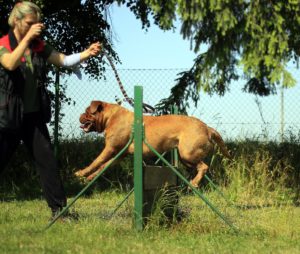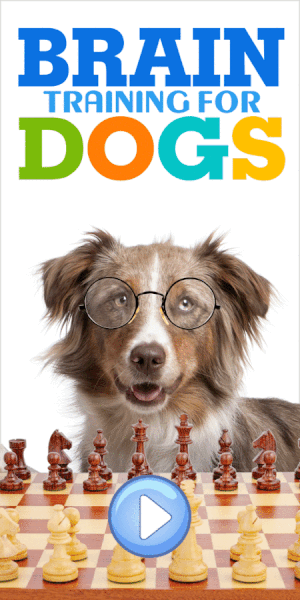Hi, my name’s Tiara Nixon! I’m a certified dog trainer based in California and I currently reside on a farm with a horse, 3 cats and 2 French Bulldogs!
Today i’m going to be taking a look at the online dog training course, Brain Training For Dogs (Braintraining4dogs) and giving you my honest review of it!
Firstly, is it possible to train your dog on your own through online modules and videos? This review is going to answer that question from the perspective of a professional dog trainer.

I’ll be honest, as a dog trainer and animal professional for over 20 years I’m always skeptical of training courses online.
I have been hands on with several hundred dogs, and it’s hard to fathom an inexperienced dog owner not having help when teaching something new.
With my guidance, my students have gone on to be therapy teams, show dogs, and AKC Canine Good Citizens.
I have always been an active participant in my students learning and problem solving, which is why I’m a bit unsure of online programs.
But hopefully this Brain Training For Dogs review will help to install some confidence in online dog training programs!
So what is “brain training” for dogs? The creator, dog trainer Adrienne Farricelli, describes it as “developing your dog’s intelligence” but what it really means is training your dog through force-free activities designed to engage the mind.
Brain Training for Dogs uses a series of 21 fun games to reach this goal. The 5 course modules are taught in a series from easier to advanced, laid out in the form of traditional education: Preschool, Elementary, High School, College, University, Graduation, Einstein.
To get an initial idea of what the program is about, you can watch the video below!
So, let’s get into my Brain Training For Dogs Review!
Science Based Dog Training
To begin my review of Brain Training For Dogs, I think it’s important to look at the underlying principles that the program is built upon.
There are many different schools of thought when it comes to dog training. There are celebrity trainers who push “pack theory” and there are others who recommend a science based approach– which is what you’ll find in the Brain Training for Dogs course.
Recent evidence has shown that pack theory training is not the most effective training method; dogs are not wolves and the original basis for pack theory training was conducted on captive wolves whose relationships are not the same as dogs or wolves in the wild.
Just like the wolf evolved into the dog, training has rapidly evolved over the last 5 decades. While positive training is now the norm, in the 90’s and earlier most trainers taught dogs using choke chains and pinch collars. They promoted harsh, punishment based methods.
As a former zookeeper and someone who has trained many species of animal, I am all for science based training. Science based training is universal, positive and understandable by multiple species. Do an internet search for “clicker training chickens” and see what I mean.

So what is “science based training?” To put it simply, it’s a way to shape the behaviors you want through a consistent, conditioned marker. Huh? I know, it’s confusing. Let me break it down.
Have you ever heard of Pavlov’s dogs? For those who haven’t, scientist Ivan Pavlov realized his research dogs were accidentally trained to salivate. He was studying the dogs salivation response when being fed, but he discovered they were salivating before the food.
He surmised the dogs were responding to the sound of the assistants footsteps- which indicated food was on the way. Testing this theory, Pavlov conditioned the dogs to salivate at the sound of a metronome. Thus, classical conditioning (aka Pavlovian Conditioning) and science based dog training was born!
An Extra Thought: I’m all about science based training. As a progressive trainer I firmly believe keeping your dog mentally stimulated is critical to preventing, and even eliminating, unwanted behaviors. I often say “a bored dog is a bad dog”, and these games will certainly activate your dogs mind as well as body in many cases.
Who Is Adrienne Farricelli The Dog Trainer?
Next up in the review, let’s take a look at the founder of Brain Training For Dogs.
Adrienne Farricelli has impressive qualifications, she studied dog training in Italy and is a CPDT-KA trainer in the USA. The letters stand for Certified Pet Dog Trainer- Knowledge Assessed and are an earned credential given by the independent Council for Certified Dog Trainers.
To obtain the credencial, a trainer must meet strict requirements including: minimum number of hours training dogs (with proof), a rigorous multi-hour national exam, provide a reference from a veterinarian.
After a trainer has become a CPDT-KA he or she must participate in Continuing Education in order to retain the credential and to keep up on the latest developments in dog training.
Adrienne has written articles for many well known publications, including USA Today.
Here Is My Honest Review Of Brain Training For Dogs!
Ok, now we know the method of this course and who created it, let’s get into the Brain Training For Dogs course review itself. Right from the main page of the website you are offered a free game and a few helpful articles. As well as this, the site itself is simple and easy to navigate.
I love anything free, so it’s nice to see information and a fun starter game to get your training going. The game on offer at the time of this review was the “Airplane Game” which is included in a module of the course, you can see what the game is all about in the video below! To check if the Airplane Game is still available, click here!
An Extra Thought: When you click on the page Brain Training For Dogs button, there is no site menu or external links. The course info page is quite long, however, there is some interesting, helpful information amidst the sales page.
There is also a guide for behavior training included when you purchase the course, and the sales page has a video example of teaching your dog not to jump in a positive, force free way.
Trainers Tip: Most dog owners are not starting with an already well behaved dog when they seek training help. I suggest reading the behavior guide first if this is your situation, but don’t skimp on the obedience training!
Format Of The Dog Training Course
I really liked the format of Brain Training For Dogs so I thought I’d mention it in my review.
The course is laid out in sequence with the intention that the games/skills build on each other. Lessons in the College module will be harder to obtain if you have not completed the previous modules.
Each module has an introduction page which contains links for each lesson. This organized format makes it easy to pick up where you left off.
There are forward and back buttons on the bottom of each page to move to the next or previous lesson. Each lesson includes a list of what items you’ll need at the top of the page which is very handy.
The font is large and there are a lot of pictures with diagrams and text bubbles for better understanding. Important tips are in a different color making them easy to see. Within the course there are helpful details such as tips at the end of the lesson, and the ability to hover over glossary terms to see the definition.
At the end of the course a full, printable glossary is provided.
Are The Lessons In Brain Training For Dogs Good?
 To really conduct a solid review of Brain Training For Dogs, I needed to take a detailed look at the actual content offered.
To really conduct a solid review of Brain Training For Dogs, I needed to take a detailed look at the actual content offered.
The course starts with an introduction module to help you train successfully. After the introduction are the Obedience lessons.
I found this section delightful and easy to follow. Adrienne provides multiple ways to train most lessons, some with props which is very helpful when training alone.
My favorite lesson in the Obedience section is Take It/Leave It which is often under taught and yet vitally important to your dogs health and well being!
Trainers Tip: Don’t skip the obedience lessons. Even if your dog already knows the basics, a refresher and polish is ALWAYS in order. Also, mastery of some of these is required to be successful in later games.
The first module after Obedience is Preschool. It may seem counterintuitive to call it that as your dog has (hopefully) already done well with the obedience and has a good foundation to his or her education.
However, the Preschool lessons include target training and two attention games which are highly important to being successful as your dog moves forward.
Often a building block training system works best when you work in order and don’t move on until your dog demonstrates a solid understanding of the task.
An Extra Thought: I would not have formatted Preschool after obedience as the games in this module will only increase your obedience training response.
Next is Elementary where your dog will get have fun with games like the “muffin tin” and “ball pit”. Adrienne suggests the use of “high value” treats for times where your dog is harder to motivate. I don’t think that will be the case with the muffin tin game and it’s worth investing in a 12 pack of tennis balls!
An Extra Thought: The ballpit game is one where you’re not likely to have the items you need on hand. There are substitutions provided, though I can’t imagine it’s quite as fun.
From Elementary you’ll go to High School. This section is neat because your dog will learn how to calm down on cue and includes games that are the basis for scent work. Scent work is fun, engages the dogs mind and body, and gives your dog purpose.
After High School comes the College module. This one continues with more scent work and games that encourage patience as well as build confidence.
An Extra Thought: I felt like some of the games in this module were not necessary to progressing training with the exception of Open Sesame. This game teaches a skill that is vital and potentially lifesaving. I’m thrilled this program offers training for critical behavioral skills that other programs do not typically offer standard.
From College to University, your dog is moving up in the world! This module is definitely introducing more advanced concepts, but again, the information is provided in an easy to follow format. The Hide and Seek game is one I taught often in my group classes.
It is an excellent foundation game for search and rescue or service dog training but really, you will be surprised how often you will use this skill with your dog!
Trainers Tip: Be careful about rushing your progress. If your dog is not showing mastery of a skill needed to complete a game at this point, take it down a step.
After all these modules, you will move to Graduation and beyond that, Einstein (Genius).

Between these two modules you will learn games that will increase scent discrimination, prepare your dog for agility training (as with other games in this program) and perform interesting tricks.
If you plan to go into agility training, retrieving, search and rescue, service dog or other advanced programs, these lessons will be good for your dog to know.
The Name Game helps your dog associate items with names and will make training in agility easier as your dog must learn left, right, go out, name identified behaviors.
An Extra Thought: These aren’t necessary for a well behaved dog, however, if you decide to teach them, you will be amazed at the things your dog can do!
Other Information About Brain Training For Dogs!
There’s a couple of extra bits of information that I thought were worth mentioning in my Brain Training For Dogs review.
Firstly, the membership also includes an incredible wealth of information that is categorized and easy to find. Topics are Puppy Training, Behavior Problems, and, my favorite, Case Studies.
The information is not displayed in the same lesson format as the Brain Games course, but the articles are informative and detailed without being too much.
An Extra Thought: I have easily read 25+ books on dog training. I often struggle to get through them because the information is presented in a technical way with too much information. Adrienne’s articles are straightforward and easy to grasp.
Each one of these topics is a full class worth of info. For example, the Puppy Training section has articles on potty training, socializing, puppy learning and development stages, and how to stop your puppy from engaging in unwanted behaviors (such as hand nipping).

The section on potty training is comprehensive yet easy to follow. Adrienne offers 7 potty training strategies and troubleshooting.
The Behavior topic has a menu with 5 choices: whining, barking, jumping, digging, and chewing.
Within some of these options there are sub-options which makes training for your specific problem much easier.
For example, Under whining there are 4 subtopics to help with the specific type of whining that is plaguing you.
Adrienne provides examples of dog body language that every dog owner should know, and she reiterates them in lessons where you’re most likely to see the behaviors.
An Extra Thought: While there is a great deal of information to help with behavioral issues, they aren’t laid out in a course format, in the same way as the rest of the information.
Real Life Results From Brain Training For Dogs!
My favorite section, as a dog trainer, is the Case Studies. Here Adrienne introduces members to 2 dogs (as of this writing) who were brought to her for training.
Videos show the negative behaviors with explanations as to what might be the cause(s), and the actual techniques she used to train these dogs.
It’s fun to watch the progression the dogs make, and also to see Adrienne apply her techniques to unfamiliar dogs.
There are also some examples of real life results from dog lovers who have bought the program, on the sales page, which can be found HERE.
Also a writer for OfficiallyPets, Leah Spaulding, has recently began using the program, to train her dog Bean! You can find their journey with weekly updates and her review of brain training for dogs here!
So overall, the reviews of Brain Training For Dogs seem to be very positive!
You can also see Adrienne Farricelli putting her skills to the test, in the video below, where she treats a whining rescue dog!
How Much Does Brain Training For Dogs Cost?
This is an important question and after navigating the incredibly long sales pitch for the course, I fully expected it to cost a lot.
When evaluating the cost of any training program there are many factors to take into account, is the program easy to follow, what is the time commitment, what is the experience of the trainer, what are the methods, is there support?
Since the program is set out like the school system, I thought it would be fun to grade the course based on my criteria! So, let’s explore these considerations in more detail and give my final verdict to conclude my Brain Training For Dogs review!
– Is it easy to follow?
A self-training program needs to be easy to follow with clear directions that make sense. Since there isn’t a trainer there to answer questions, clarity is key. Just like people, not all dogs will learn in the same way and a good, experienced trainer presents information in bite sized pieces that progress in difficulty.
The course information is clearly presented, therefore I’m presenting it an easy to follow score of A.
– What is the time commitment?
Let’s face it, most of us don’t have all day to spend on dog training and reinforcing training. We have jobs, families, chores, and hobbies. An effective training program breaks lessons down into 10-15 minute sessions so they can be easily added to a busy life.
With lessons broken down into quickly paced games, I give this course a time commitment grade of A.
– Is it taught by an experienced trainer whose methods I agree with?
 This is a big factor when I review any dog training program, so Brain Training For Dogs, is not different!
This is a big factor when I review any dog training program, so Brain Training For Dogs, is not different!
As a teacher of many, many group classes, I always stress the importance of being comfortable with the methods being used.
The reality is, some people are uncomfortable with certain methods so it’s vital your ethics align with the trainer you choose. If you disagree with a trainers philosophy, you’re likely to quit training.
Adrienne’s methods are science based and positive. She does not use any harsh training techniques and always keeps the focus on what will help the dog to learn.
She also has a great deal of experience that she has backed up with certification. With that in mind, I give this an experienced trainer grade of A.
– Is there personalized support?
Every dog- and every dog person- learns in their own way. Therefore, a one-size-fits-all approach to dog training rarely works. Unless, of course, it’s a conditioning approach, such as Brain Training for Dogs, and patience is used!
Trainers Tip: If your dog doesn’t seem to be “getting it” try taking a step back, asking the dog something it knows really well to build confidence and break the step you’re teaching into smaller parts.
It is mentioned quite a few times throughout the site that support via email is provided for members. Since I have no experience with the support I give personalized support a grade of B.
An Extra Thought: About the only way to get an A here is offer in person or live video messaging options where the trainer can see the issue the owner is experiencing. However, there is enough additional material that it’s quite possible you’ll find the answers you need without resorting to contacting Adrienne.
– Bottom Line: Is Brain Training for Dogs Worth It?

An online search for books about brain training for dogs yielded only a few decent results with an MSRP of $19.95. Behavior modification books were even more, around $25 MSRP and dog training DVD’s were $18-$20 and up.
To get a comprehensive training guide, a behavior guide and videos, you are looking at spending about $60 and that’s without all the information in one, easy to use format and the additional resources.
Brain Training for Dogs is only $47 including the extras.
My verdict: yes! It is well worth the price! And if you become a member and decide it wasn’t what you were expecting, there is a money back guarantee. It satisfies me that this trainer is willing to stand behind her work!
Trainers Tip: While the Brain Training for Dogs course has great information that will assist most dogs, please consult a professional if your dog exhibits signs of extreme or dangerous aggression to people or other animals. There is no substitute for professional help when safety is in question.
Final Thoughts For My Brain Training For Dogs Review
So, we’re nearing the end of what has been quite a lengthy, but hopefully helpful review of Brain Training For Dogs!
My final verdict is that, I would highly recommend this course to anyone seeking to train their dog in a fun, meaningful, and easy way. The games are designed to progress your dogs skills in an easy to follow format, without a lot of jargon.
While some items for games are not likely to be things you have on hand, they are easy to source new or used, and Adrienne provides substitutions.
While I still believe in working one on one with a trainer, this program is a great substitute when commitments or lack of options make attending a class difficult.

Pros
*Easy to read with lots of pictures
*Affordable for what you get
*Clearly communicated
*Created by an experienced, certified dog trainer
*In addition to Brain Games you also get obedience, tricks, beyond training tips, puppy training, and behavior training
*Troubleshooting for each lesson
Cons
*Some items required for the game are not things you would have on hand
*You’ll get addicted to training your dog!
What I love about it:
Adrienne addresses the most common issues faced when training your dog right up front.
If you don’t skip around, and follow the modules in order you should have a well behaved and mentally stimulated dog!
She offers support via email, but chances are you’ll find a lot of answers to issues in the archives.
Overall, a massive wealth of knowledge for a very reasonable price!
Thanks for reading my Brain Training For Dogs Review!
If you haven’t already, you can check it out by clicking here!
